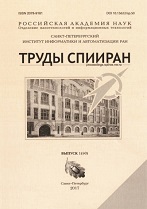|
|
Trudy SPIIRAN, 2009, Issue 11, Pages 52–62
(Mi trspy46)
|
 |
|
 |
Phenomenon of identification
V. V. Alexandrov, S. V. Kuleshov, B. Shannaq
St. Petersburg Institute for Informatics and Automation of RAS
Abstract:
The uniform information space of Internet community results in chaos of “languages” (different texts, disordered symbols, terms and terminology). Professional oriented languages appear and disappear in order to serve various technology processes including ontology process of knowledge representation.
Knowledge itself is not contain in books, magazines, newspapers, computer disks, Internet and other information carriers. This is only form of storage for data, facts which is being initialized by each individual depending on personal training level, given education, social and cultural aspects of surrounding community.
The whole civilization history reflexes in evolution of language — effective instrument for identification and infocommunication. The invariance of forms and specific features of knowledge representation in symbolic form and text emerges from Plato's postulate: subjects name and it's figurative and speech designation must reflect it’s properties and to be it's unique identifier.
The solving of semantic ambiguity had demanded to develop mathematic search methods for one-to-one correspondence of identical, physical process and mathematical model data identification (record formalization). In another words: phenomena of mutual identification is in unequivocal relation with the physical reality data and simple mathematical model. For reliable (observable and experimental) data only one model to explain them exists.
Keywords:
grow, digital civilization, identification, infocommunication.
Received: 06.07.2009
Citation:
V. V. Alexandrov, S. V. Kuleshov, B. Shannaq, “Phenomenon of identification”, Tr. SPIIRAN, 11 (2009), 52–62
Linking options:
https://www.mathnet.ru/eng/trspy46 https://www.mathnet.ru/eng/trspy/v11/p52
|

| Statistics & downloads: |
| Abstract page: | 456 | | Full-text PDF : | 175 | | References: | 2 | | First page: | 1 |
|




 Contact us:
Contact us: Terms of Use
Terms of Use
 Registration to the website
Registration to the website Logotypes
Logotypes








 Citation in format
Citation in format 